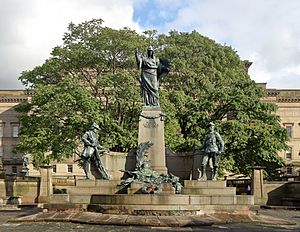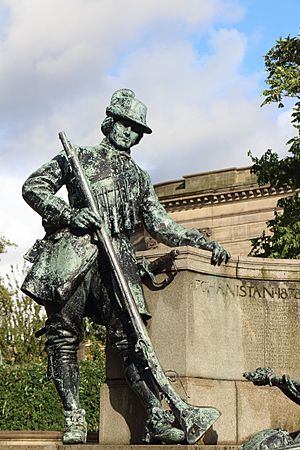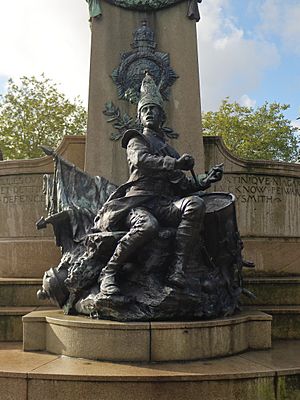Monument to the King's Liverpool Regiment facts for kids
Quick facts for kids Monument to the King's Liverpool Regiment |
|
|---|---|
| United Kingdom | |
 |
|
| For Members of the King's Regiment (Liverpool) who lost their lives on campaign in Afghanistan (1878–1880), Burma (1885–1887) and South Africa (1899–1902) | |
| Unveiled | 4 August 1905 |
| Location | 53°24′32.1″N 2°58′53.7″W / 53.408917°N 2.981583°W St John's Gardens, Liverpool
|
| Designed by | William Goscombe John |
|
THE KING'S LIVERPOOL REGIMENT
|
|
|
Listed Building – Grade II
|
|
| Official name | Monument to the King's Liverpool Regiment |
| Designated | 14 March 1975 |
| Reference no. | 1073470 |
The Monument to the King's Liverpool Regiment is a special war memorial found in St John's Gardens in the heart of Liverpool, England. This monument remembers the brave soldiers from the King's Regiment (Liverpool) who died while fighting in different wars. These included the Second Anglo-Afghan War (1878–1880), the Third Anglo-Burmese War (1885–1887), and the Second Boer War (1899–1902).
People in Liverpool helped pay for this monument. It was officially revealed on August 4, 1905, by a famous army leader, Field Marshal Sir George White. This monument is quite special because it's one of the few large memorials built for a specific army regiment before World War I. It features a main statue of Britannia, who represents Britain. There are also statues of soldiers from the regiment from different time periods: 1685, 1743, and 1902.
Contents
The King's Regiment: A Brief History
The King's Regiment (Liverpool) has a long and interesting history. It started way back in 1685. It was first called "Princess Anne of Denmark's Regiment of Foot." This group was formed to help stop a rebellion against James II of England, who was the father of Princess Anne.
Later, when Anne became Queen, the regiment was renamed the "Queen's Regiment." After they helped during the 1715 Jacobite rising, King George I changed its name again to the "King's Regiment." In 1881, the British Army decided that each regiment should be linked to a specific town for recruiting new soldiers. The King's Regiment was then officially linked to Liverpool.
How the Monument Was Built
The King's Regiment played a part in the Second Boer War (1899–1902). They were involved in the Siege of Ladysmith, a very important battle. Because of their bravery, people in Liverpool suggested building a memorial to honor the regiment.
On February 11, 1902, the Lord Mayor of Liverpool, Sir Charles Petrie, held a public meeting. Everyone agreed to build a monument for the officers and soldiers who died in Afghanistan, Burma, and South Africa. The city of Liverpool even gave land for the monument in St John's Gardens. These gardens used to be a church and graveyard, but they were turned into a beautiful memorial garden by 1904.
Designing and Funding the Memorial
People donated £3,000 to pay for the monument. This was a lot of money back then! A special committee was formed to oversee the design and building. Many important people from Liverpool were part of this group.
They asked a talented Welsh sculptor named William Goscombe John to create some designs. He showed them two ideas on November 7, 1902. The committee loved one of the designs and chose it right away. The city council also approved the design on April 1, 1903. The stone parts were made by Messrs William Kirkpatrick Ltd, and the bronze statues were made by A. B. Burton.
The monument was finished by August 4, 1905. It was officially unveiled by Field Marshal Sir George White VC on September 9. Sir George White had led the British forces at the Siege of Ladysmith. In his speech, he praised the regiment for their brave actions in that battle. It's quite rare for a monument to a specific regiment to be paid for by the public, rather than by the regiment itself.
What the Monument Looks Like
The monument is made of white stone with detailed bronze parts and statues. In the middle, there's a stone base with a bronze statue of Britannia on top. Britannia is a female figure who represents Britain. She stands with her right hand raised and holds a laurel branch in her left hand. Laurel branches are a symbol of victory and honor.
She has a round shield on her left arm, decorated with sea horses. On her head, Britannia wears a helmet with a ship's front (prow) and a sea horse crest. The sea horses show how powerful Britain was at sea.
Details on the Pedestal and Walls
The stone base (pedestal) has bronze decorations at the top. On the front of the pedestal, there's an inscription. It says that the monument was built by the regiment's soldiers and the people of Liverpool. It remembers those who died in Afghanistan (1878–80), Burma (1885–87), and South Africa (1899–1902). This includes those killed in battle, those who died from injuries, and those who died from illness.
In front of the pedestal, there's a bronze display of guns and other military gear, along with wreaths, palms, and a Union Flag. Below this, in bronze letters, are the words "Pro Patria." This is Latin for "for one's country." A laurel wreath lies on a lower step in front of this. At the back of the pedestal, you can see a bronze picture of the regiment's badge, which includes a sphinx and a laurel twig. The front base of the monument also has the regiment's motto: "Nec Aspera Terrent." This means "Difficulties be Damned" or "No Hardships Deter Us."
Two curved walls extend out from the main pedestal. At the end of the left wall, there's a bronze statue of a soldier from 1685. At the end of the right wall, there's a soldier from the 1902 Second Boer War. The front of the left wall lists the names of 66 men who died in the Second Anglo-Afghan War and 110 from the Third Anglo-Burmese War. The front of the right wall lists the 179 who died during the Second Boer War.
The back of the curved walls lists the regiment's "battle honors." These are special awards for battles they fought. The left wall lists honors from the 18th century, like Blenheim, Ramilles, Oudenarde, Malplaquet, and Dettingen. The right wall lists 19th-century honors, such as Martinique, Niagara, Delhi, Lucknow, Peiwor-Kotal, and Ladysmith.
Behind the main pedestal, there's a statue of a drummer boy from the Battle of Dettingen (1743). He is sitting on a rock, beating his drum to call soldiers to action. Behind him are bronze banners, a cannon, and a musket.
The Monument Today
This monument was given special protection as a listed building on March 14, 1975. It is currently a Grade II building. This means it's an important historical structure that needs to be preserved. It's still the biggest memorial in St John's Gardens.
The War Memorials Trust has noted that the monument is in "poor" condition. There has been some damage and vandalism. They have seen graffiti on the stone, missing bronze letters, and a broken palm leaf. Some small parts are also missing, like a plume from a hat, triggers from guns, and the tip of a flag staff.




